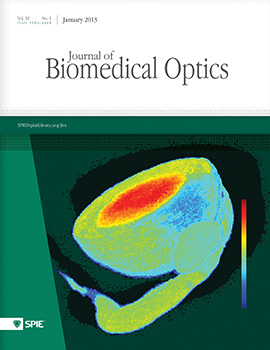Runze Yang, Qiong Zhang, Ying Wu, Jeffrey Dunn
Journal of Biomedical Optics, Vol. 18, Issue 01, 016011, (January 2013) https://doi.org/10.1117/1.JBO.18.1.016011

TOPICS: Hypoxia, Calibration, Near infrared spectroscopy, Blood, Tissues, Brain, Oxygen, Capillaries, Oximeters, Animal model studies
Angiogenesis is a hallmark of many conditions, including cancer, stroke, vascular disease, diabetes, and high-altitude exposure. We have previously shown that one can study angiogenesis in animal models by using total hemoglobin (tHb) as a marker of cerebral blood volume (CBV), measured using broadband near-infrared spectroscopy (bNIRS). However, the method was not suitable for patients as global anoxia was used for the calibration. Here we determine if angiogenesis could be detected using a calibration method that could be applied to patients. CBV, as a marker of angiogenesis, is quantified in a rat cortex before and after hypoxia acclimation. Rats are acclimated at 370-mmHg pressure for three weeks, while rats in the control group are housed under the same conditions, but under normal pressure. CBV increased in each animal in the acclimation group. The mean CBV (%volume/volume) is 3.49%±0.43% (mean±SD) before acclimation for the experimental group, and 4.76%±0.29% after acclimation. The CBV for the control group is 3.28%±0.75%, and 3.09%±0.48% for the two measurements. This demonstrates that angiogenesis can be monitored noninvasively over time using a bNIRS system with a calibration method that is compatible with human use and less stressful for studies using animals.



 Receive Email Alerts
Receive Email Alerts